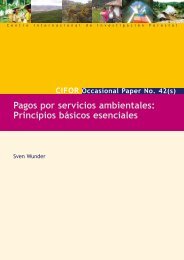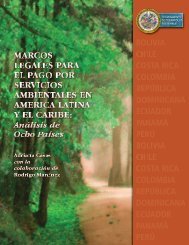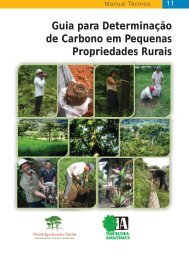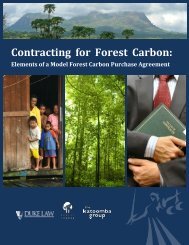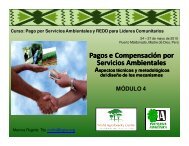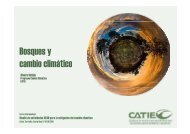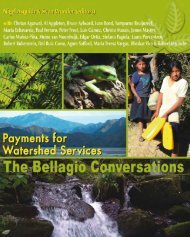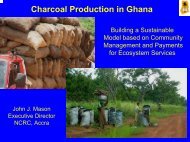Guide on Climate Change and Indigenous Peoples
Guide on Climate Change and Indigenous Peoples
Guide on Climate Change and Indigenous Peoples
- No tags were found...
You also want an ePaper? Increase the reach of your titles
YUMPU automatically turns print PDFs into web optimized ePapers that Google loves.
10Why should traditi<strong>on</strong>al knowledgeof indigenous peoples be centrallyc<strong>on</strong>sidered in issues related tobiodiversity <strong>and</strong> climate change?• <strong>Indigenous</strong> peoples have proven sustainable envir<strong>on</strong>mental practices(See Box below).• <strong>Indigenous</strong> peoples also c<strong>on</strong>sider care <strong>and</strong> maintenance of biodiversityas their resp<strong>on</strong>sibility (Turner, 2007). In their traditi<strong>on</strong>al world views,animals <strong>and</strong> plants, as well as other comp<strong>on</strong>ents of nature are regardedas relatives or sacred entities “willing to give themselves to peoplewithin a reciprocal system that dem<strong>and</strong>ed proper care <strong>and</strong> respect inreturn.”• Toledo (2000) has asserted that scientists from the fields of c<strong>on</strong>servati<strong>on</strong>biology, linguistic <strong>and</strong> anthropology of c<strong>on</strong>temporary cultures,ethnobiology <strong>and</strong> ethnoecology, have evolved towards c<strong>on</strong>vergence<strong>on</strong> a shared principle: the world’s biodiversity will <strong>on</strong>ly be effectivelypreserved by preservingdiversity of cultures <strong>and</strong>vice versa. This comm<strong>on</strong>statement has beennourished by four mainsets of evidence: The most biologicallydiverse regi<strong>on</strong>s in theworld also have themost linguistic diversityThe most biologicallyhigh-value regi<strong>on</strong>sin the world areindigenous territoriesThe recognizedimportance ofindigenous peoplesas main managers<strong>and</strong> dwellers of wellpreservedhabitats, <strong>and</strong>Certificati<strong>on</strong> ofc<strong>on</strong>servati<strong>on</strong> values<strong>and</strong> behavior am<strong>on</strong>g<strong>Indigenous</strong> <strong>Peoples</strong>’SustainableEnvir<strong>on</strong>mental Practices• The indigenous peoples of BritishColumbia c<strong>on</strong>sider biodiversity atthe broader scale of communityor ecosystem variati<strong>on</strong> criticallyimportant. People routinelyaccessed different habitats, withdifferent groups of resources, fromthe ocean <strong>and</strong> valley bottoms tothe high mountaintops.• First <strong>Peoples</strong> have maintained<strong>and</strong> enhanced plant <strong>and</strong> animalpopulati<strong>on</strong>s <strong>and</strong> productivity <strong>and</strong>increased habitat diversity throughresource management strategiesthat, as a result, yield a greatervariety <strong>and</strong> abundance of foods<strong>and</strong> materials (Turner, 2007).106 <str<strong>on</strong>g>Guide</str<strong>on</strong>g> <strong>on</strong> <strong>Climate</strong> <strong>Change</strong> <strong>and</strong> <strong>Indigenous</strong> <strong>Peoples</strong>



